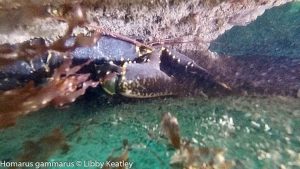By boat from Glenarm, follow the coast in a southerly direction for approx. 3km.
If diving from the shore there is a lay-by and a path down to the entry point. There is a bit of a swim out to the wreck from the shore. Shore entry and exit not for the fainthearted, especially at low tide, or if there is any swell.
For boat diving, Glenarm Marina offers a slipway and free car parking.
For shore diving, car parking is available on the lay-by on the Coast Road above the site. Public toilets are available in Glenarm, across the footbridge from the harbour.
- There is a slight climb down from the lay-by to get to the rocky shore.
- Shore entry can be difficult due to large rocks and boulders. Strongly advise diving at HW.
- If diving from boat there are lobster pots in the area to be aware of.
- The wreck is badly broken up so beware of sharp edges.
The wreck is badly broken up, but the mast, boiler and various other sections of plate are still easily distinguishable, especially in the winter when the kelp is reduced. The surrounding seabed is made up of boulders and sand.
Date of loss 11/04/1917. Built originally as a Royal Navy gunboat in 1889 in Greenock. Used as a gunboat, coastguard vessel (from 1906), cable laying ship (from 1915) and operating as a Royal Fleet Auxiliary salvage steamer at time of sinking. Nine of the crew were lost when she sank during a snow-storm. The rest of the crewmen were rescued, and fed and clothed by locals. The nine crew who perished were buried in Glenarm. (Sources: Larn & larn 2002; Ms. L. Keatley).
Information derived from Historic Environment Record of Northern Ireland (HERoNI), Department for Communities, Historic Environment Division.
Wrasse, crabs, sea urchins, sponges and sea anemones are all found on the wreck.
View all species records from this site
A link to the dive site location on the NBN Atlas Northern Ireland website, showing all species records from within a 1km boundary of the site centroid. Any new species records from the site submitted to Seasearch, iRecord, CEDaR Online Recording or iNaturalist will appear here- In an emergency call 999 or 112 and ask for the coastguard.
- Follow VHF radio Channel 16 (156.8 MHz), the international distress frequency. Send a distress alert followed by ‘MAYDAY, MAYDAY, MAYDAY’ and ‘This is [boat name]’.
- Find nearest defibrillator (AED) here.
- Glenarm Harbour Office: 028 9336 6666
















Leave a Comment
Dived here recently? Then let other divers know about this site from your experience!